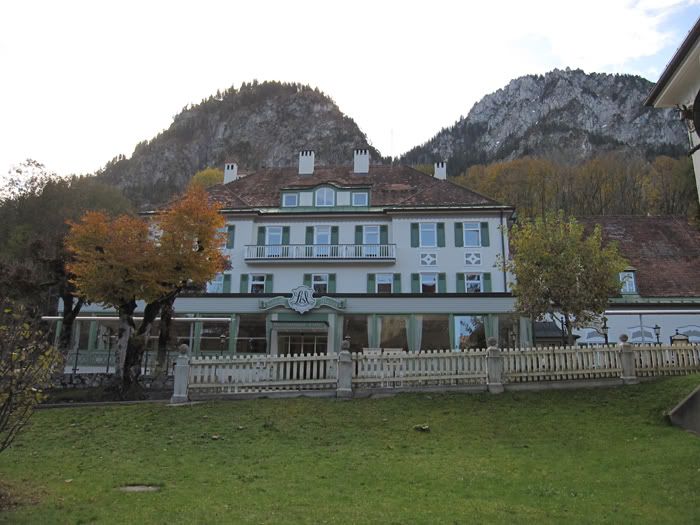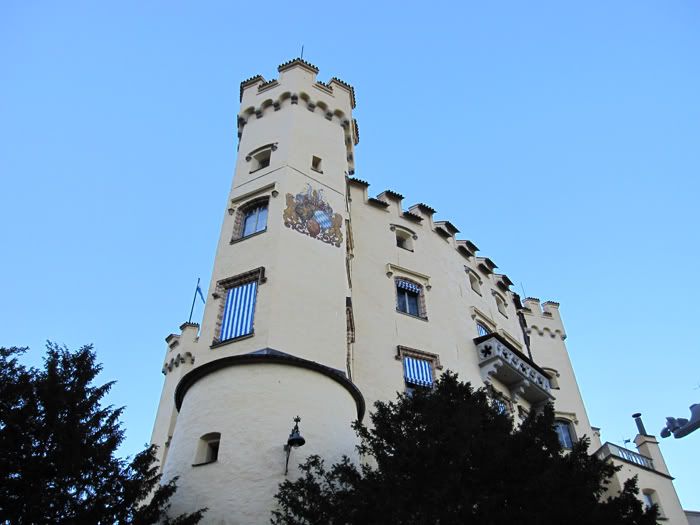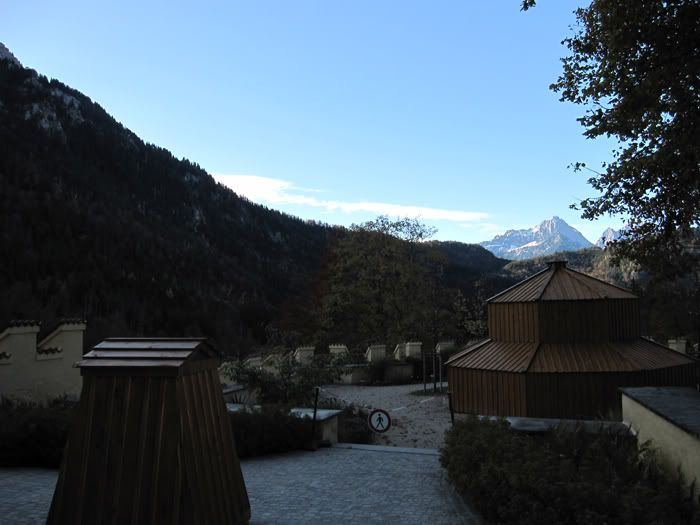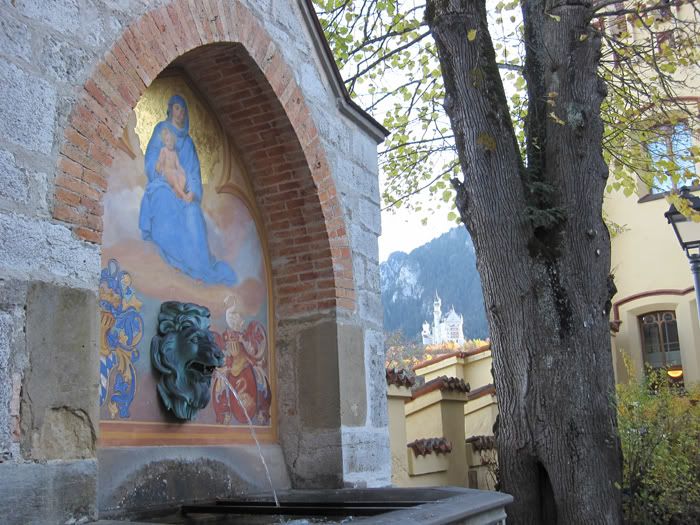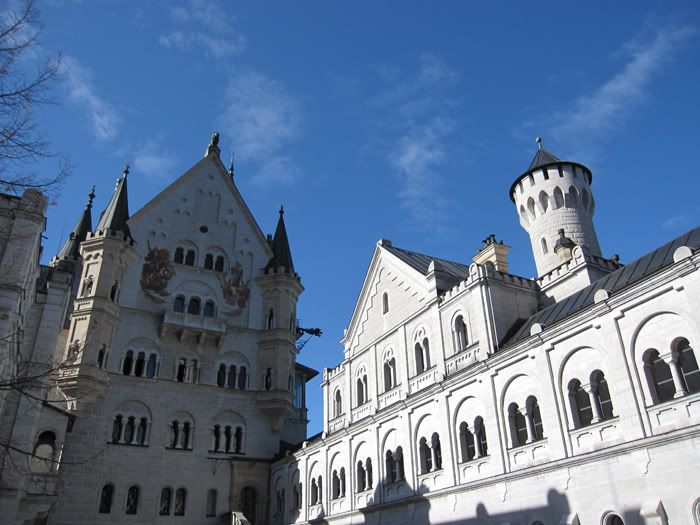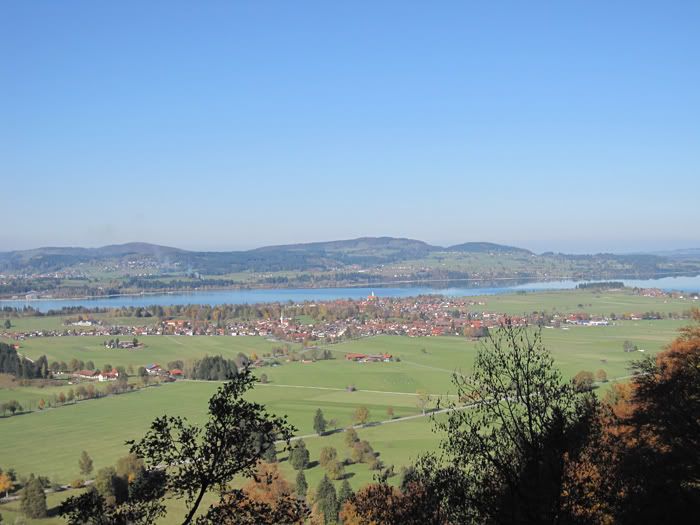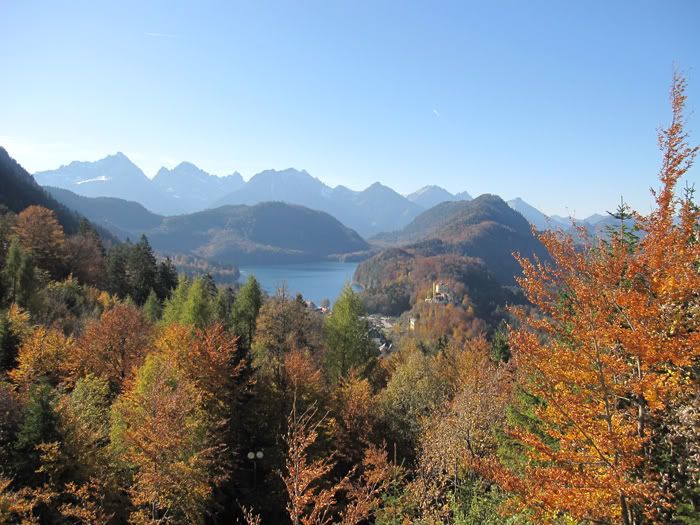It's already Thursday, October 29th - about a third of the way into the trip already, even though it felt like I was just getting started. Already, the previous night in the town of Hohenschwangau was going to be my last of five nights in German territory; at the end of the day, I was going into Austria.
Again, jet lag has gotten the better of me. It's about 4 in the morning, and sleepless again, I am out and about in the hotel parking area, where the temperatures are barely above freezing. Sure, sheltering myself in the car helps a bit, since I need to continue to fiddle with its settings to get to know them better. At least the factory had made sure to provide me with the North American English manuals for the car itself, and for the COMAND navigation system, so that I wouldn't be left in the dark regarding the car's features. (I would get another set of the manuals upon redelivery in the US.)
At least I am enjoying this stunning view of floodlit Hohenschwangau Castle. Hohenschwangau remains lit all night, while Neuschwanstein's floodlights are turned off at 1:30 in the morning, according to the hotel night clerk. Though it's gonna still be a long wait before morning comes, the castles open for visit, and I take my turn visiting each.
It's morning, and I have just purchased tickets for the combined Royal Tour, covering both castles in order. However, since it will be a while before my English-language tour starts, so I'm walking around the town.
This is Alpsee. In German, a placename ending with "-see" can be any body of water, often a lake. This lake is usually framed as the stunning backdrop on posters depicting an aerial view of Neuschwanstein. It's still chilly this morning, but feels extremely fresh here at the base of the Alps, and I'm loving it. And for the record, this is my first time experiencing rugged terrain in Europe.
Nearby trails indicate that a short walk along the lake's shores and beyond will take me into Austria's Tirol province.
Now checked out of the Lisl, and I am looking back at this pricey but very charming hotel.
As it turned out, breakfast was not part of my rate, and it cost me another €20 for two buffet breakfasts. Final cost for the night was €140 or so with the breakfasts - just over USD $200 as shown on my credit card statement, certainly NOT cheap for just a night. If I were traveling alone that'd be prohibitively expensive, but for two, this was a nice splurge.
The Lisl was the only hotel in my itinerary that had been booked for only one night. All other hotels involved at least two nights (though plans would eventually change...).
Now it's time for the first castle tour - Hohenschwangau. I have now climbed up to the courtyard of the castle, waiting for my tour.
The two castles feature many custom frescoes on the interior walls, and due to copyright issues over them, all interior photographs are prohibited. That means I have very few photos to share for this particular day. The only sure way to fully experience these castles is simply to visit in person.
Hohenschwangau's architecture resembles that of traditional medieval castles, but it's really a 19th Century Romantic reinterpretation of medieval themes, a motif that had been popular at the time. The interior frescoes are Romanticized motifs of knights and chivalry; while there are many battle scenes, there is no bloodshed, for example. The room that was used by Ludwig II has images of frolicking nude maidens - and I liked that.
In this photo, I can see the window shades, and they feature the Bavarian color scheme again. Between BMWs, the logo of the famous FC Bayern soccer club of the Bundesliga, and all the blatant displays of Bavarian nationalism, it's impossible to miss the Blau mit Weiß. Even now, every sight of a BMW automobile immediately reminds me of my Bavarian moments, and a BMW with color-altered roundels (red/white and black/silver are two common examples), common in Los Angeles but NEVER seen within Bavaria, makes me cringe. (But then, I now cringe at all BMWs anyway thanks to its involvement with the Pope.)
There is this nice patio garden at the courtyard level, but as it's cold today, I am not seeing much life. On a summer day this place would be much nicer. But then, maybe the tourist mob may NOT be such a good idea. These castles are notorious for long lines and sold-out tours, but since my visit is at the tail end of October, I am spared from that insanity.
Here is a detail of a courtyard fountain, showing a Catholic motif of Madonna and Child. After all, Bavaria's Catholicism is to be duly noted again and again. The gold-leafed halo is, again, a medieval inspiration. Also love the balance of the Bavarian blue/white on the left with the red swan knight imagery on the right.
Neuschwanstein is visible in the distance. When the sun rises, the sun rays strike Neuschwanstein first - it's quite a sight. It had been the site of two previous medieval castles, and for the same reasons, King Ludwig II placed the castle there in the 1880s.
Ludwig II ruled at a time when Bavaria ended up losing its sovereignty. He simply refused to deal with the political headaches, and simply withdrew himself to his longtime fantasy, castle-building, which had been inspired by his father. He bankrupted the national treasury and his own family fortune building a number of fantasy castles throughout Bavaria; the largest of them, at Herrechiemsee (on a huge lake on the way to Salzburg), was to feature a huge Hall of Mirrors even grander than the famous one at Versailles in France. Eventually, he was declared mentally unfit to rule (hence the "Mad King" title), and two days later, he was found dead; suicide or murder, the cause of death was never conclusively proven. The castles eventually opened to the public for tours within weeks.
Done with Hohenschwangau, now I have arrived at Neuschwanstein, after a mile-long hike from the town. The climb can also be done with horse-pulled carriages or a bus, though at a price. A nice waterfall at Marienbrücke (St. Mary's Bridge), on a back trail, was a stunning sight that I did not get to experience up close, though I could constantly hear the waterfall roar while waiting for this castle's tours and afterwards.
While the castle's architecture is very medieval Gothic, again, it dates only from the 1880s. And the walls are so clean and stain-free that from this point, the castle looks even newer.
The interior features a stunning Byzantine throne room, but otherwise is disappointing. The castle had been designed with five levels, but only the top two were ever completed, and one of the uncompleted levels served as a souvenir shop. The living level, to fulfill Ludwig's fantasies, even had a miniature cavern, which I walked through.
Neuschwanstein affords an excellent view of the town of Füssen as well. Those red tiled roofs are quite a sight - and a very common motif throughout Bavaria.
The body of water seen here, Forggensee, is an artificial reservoir dating back only to 1959. That means my view is even better than the view that Mad King Ludwig himself had ever had.
And here is a truly magnificent view of Alpsee from Neuschwanstein, as I wrap up my tour. Because of the fall foliage, October is considered by many to be the best time to visit the castles, and I am glad that this is indeed my timeframe.
It is early afternoon, and aside from the two castles, there are no other sights of interest in the immediate area. Time to start driving again. I headed back into Füssen first, to buy some gasoline as well as the Austrian toll sticker. While a supermarket sold me premium 95-octane (91-octane by US methods, German regular is 91 European/87 US) gasoline at about €1.38 or so per liter, it could not sell me a toll sticker, so I had to go to a retail gas station down the street. Unfortunately, when I asked the elderly lady cashier there "Sprechen-Sie Englisch?" the answer was a flat-out "Nein," and that simply became an opportunity for me to put the scraps of German I had picked up to good use. She and I strung together the words "Österreich vignette zehn Tagen" (Austrian toll sticker, ten days validity), and I walked away with a properly validated ten-day toll sticker for €7.70.
I returned to Autobahn 7, where the onramp indeed indicated "Austrian toll sticker required beyond this point" - and the Autobahn immediately entered a tunnel, and there was a European Union sign with the letter A in the middle. Yes, it was the Austrian border - and the border crossing was as much of a non-event as crossing US state lines. Austria became my sixth European country with this entry, and the first new European country I entered since entering Germany from Amsterdam for a day trip in December 1999.
My routing started on Austrian Highway 179, the natural extension of Autobahn 7, proceeding through a very scenic Alpine country straight out of postcards. A turn-off onto Highway 187 would take me back to Germany, right under the slopes of the Zugspitze and into Garmisch-Partenkirchen. I loved the Austrian scenery, but did not care for Garmisch too much; on a future visit, I would love to return to Garmisch, if only to ride the Zugspitzebahn up to Germany's highest point, but on this trip, where Jungfrau is on the agenda, it was better to push ahead.
Back in Germany, I picked up Autobahn 95 out of Garmisch, which returned me to Munich - in fact, within a few blocks of the neighborhood I had stayed in a few days earlier. After some surface street driving to navigate the ring road, I finally picked up the eastbound Autobahn 8 for the hourlong drive to Salzburg.
Just outside Munich, I pulled into a rest area, where I decided to eat a Burger King meal (my mother's suggestion, I would've chosen something more local). The young lady at the cash register, presumably an Eastern European immigrant, spoke no English; again, time to string together a few German words to place my order. As I ate, I was able to watch a family-friendly television program; but this being Europe rather than puritan US, even a family-friendly television program could easily involve nudity - in this case, a woman trying on new bras after a reconstructive surgery. And no, no need to pixelate the nipples either; this was nonsexual nudity and necessary to tell the positive story of self-image, so it would actually be a subversion of the message to pixelate anything. I love this European no-nonsense approach to nudity and body image, vastly preferable to the US BS where a mere sight of an exposed nipple is supposed to scar a child for life.
Back on the road, a bit of traffic build-up around Autobahn 93 junction (the turn-off for Innsbruck and Italy) tested my patience a bit. I slipped into my bad California habits and almost passed a fast-lane slowpoke on the right, before pulling back at the last minute; my mother protested, and when I explained the no-passing-on-right rule, she refused to believe it, at least until I showed other motorists obeying the same rule. Eventually the slowpoke moved right and traffic resumed at a normal speed, but Autobahn 8 was an old, curvy road, and while there was no hard speed limit, even the "recommended speed limit" (blue rectangle, rather than red-bordered white circle used for hard limits) was a mere 110 km/h rather than the standard 130, so I had to keep my speed down and be careful. There were plenty of rest stops on the way offering more Austrian toll stickers, and I could buy toll stickers all the way to the border itself, so there was no excuse for not having one.
As it started to darken, I found myself again in mountainous territory, and speed limits dropped significantly as I neared the customs checkpoints at the German-Austrian border. Sure, a passenger car can breeze right through - there are no checkpoints anymore in the main lanes - but trucks were still expected to pull over for an inspection, as well as cars that still needed to get a toll sticker. I also noted the "default speed limit" signs that are found at every European national border - the only reminders of a given country's speed limits, which I am expected to remember and obey in the absence of any other limits. (That'd be 90 km/h surface and 130 km/h motorway for Austria, and 50 km/h urban, 100 km/h rural, and "recommended 130 km/h but can be legally exceeded" motorway for Germany.)
In Austria, the 8 immediately split into two - Autobahn 1 toward Vienna, and Autobahn 10 toward Graz. I took the 1 for a few kilometers, and picking out a route I had previously studied, exited the motorway to proceed slowly into the heart of Salzburg. I ended up at a nice Best Western, located between the train station and the old city core, for a two-night stay, while the car, not necessary within town, would be parked at a dedicated outdoors lot, for the duration of my stay, for free as a paying guest of the hotel.
The Salzburg walking tour, covering sights related to Wolfgang Amadeus Mozart, The Sound of Music, and more, would make up the next day, and will be the next post.


